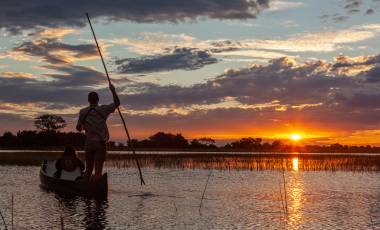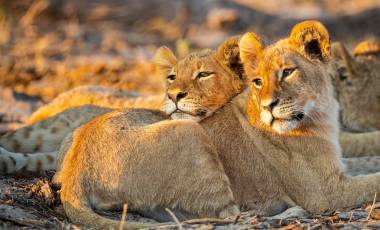We have been carefully curating our trips for 45 years and our safari holidays are designed to bring you closer to the African wildlife, with more time spent in game reserves and national parks. The main focus is to steer you to the best vantage points on game drives with expert guides and rangers who will teach you about the varied habitats and wildlife as they share their invaluable wealth of knowledge. Throughout our trips, we also arrange exceptional accommodation where you can immerse yourself in the heart of Botswana’s wilderness and meet with like-minded travellers.
Between the months of June and August are good times to plan a safari to Botswana. During these months the temperatures are cooler, so game drives are more enjoyable and there are fewer mosquitos around. In July you can usually expect floods in the Okavango Delta, which makes game viewing even more exciting as hippos, elephants and warthogs make their way down to the banks of the rivers. However, towards the end of November, zebras begin the Nxai Pan Migration south in search of rich grasses. You can also see zebras and wildebeest heading from the Okavango Delta to the Makgadikgadi Salt Pans.
Undoubtedly Africa is the best continent for safaris and playing host to some of the most magnificent animals, Botswana is often considered the ultimate safari destination. Known for its huge herds of buffalo and elephants, Chobe National Park is the place to go for game drives. The Okavango Delta is also a front runner in the safari stakes with its population of crocodiles, white rhinos and hippos that can be found in the river swamps. Alternatively, head to Moremi Game Reserve or the Makgadikgadi Salt Pans for more unique wildlife encounters.
Before you go ahead and book your trip to Botswana, make sure you do your research beforehand or speak to one of our experts to find out more about the best times to travel and when to book. We advise that you book your holiday well in advance so that you have plenty of time to apply for your visa and arrange any necessary vaccinations. If you plan to travel during the peak season, it’s recommended that you book your trip 10 to 12 months in advance. Make sure your passport has the required length of validity and if not, apply for a new one as soon as possible.
The wildlife in Botswana is as diverse as it is abundant and you’ll have the opportunity to see the Big Five, consisting of the lion, elephant, leopard, buffalo and black rhino, as well as many more species. The country also plays host to some of the continent’s greatest concentrations of giraffe, hippo and wildebeest, and has the largest herds of elephants in the world. Throughout the dry season in Botswana, there are approximately 200,000 large mammals found in the Okavango Delta. Boasting a varied ecosystem made up of salt pans, rivers, marshes and savannah, it provides the ideal habitats for a wide variety of wildlife.
There is no right or wrong answer to this question, but however long you spend in Botswana, you’ll likely feel it isn’t enough as the wildlife experiences here are endless. A week on safari would allow you plenty of time to explore some of the larger game reserves and national parks but 14 days would let you delve even deeper. Depending on how many locations you wish to visit, two or three nights is a reasonable length of time to spend at each area. 14 days would give you the best opportunity to see most of Botswana’s wildlife as well as enjoying immersive cultural experiences.
As well as six game reserves and other smaller parks, there are four national parks in Botswana, which include Chobe, Makgadikgadi, Kgalagadi Transfrontier Park (also known as Gemsbok) and Nxai Pan. Other notable wildlife parks to visit are Moremi Game Reserve, Okavango Delta and the Central Kalahari Game Reserve. Chobe National Park is the oldest in Botswana and one of the most ecologically diverse in Africa, showcasing large concentrations of big game. Makgadikgadi National Park is a quieter option and although it doesn’t have as many sightings of the Big Five, its stunning scenery is well worth exploring.



